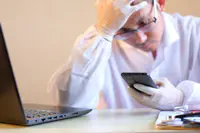Prescription Stimulants: What Are They, and Are They Addictive?
Prescription stimulants refer to a class of pharmaceutical drugs that, while they have some intended medicinal purposes, can also be abused. Many who use such drugs become hooked on them, even if they use them as directed by a doctor.

Prescription stimulants refer to a classification of drugs that have not only medicinal value but also abuse potential. The drugs are widely prescribed across America, and people need to have a better idea of the risks inherent in these drugs and what their side effects are.
Defining Prescription Stimulants
According to the Food and Drug Administration (FDA), the number of prescriptions written for pharmaceutical stimulants nearly doubled from 2011 to 2022. Prescription stimulants have become widely popular and have been rapidly distributed across the nation as a result. However, while this category of medication has some medicinal applications, people who use stimulants also put themselves at risk for addiction and other harmful side effects, even when they use the drugs as prescribed.1
Prescription stimulants are drugs meant to stimulate certain areas of the brain to produce a desired result in a patient. Some patients take stimulants to improve attention, reduce overeating, or increase wakefulness. Some are used to “help” students do better in school. Prescription stimulants have many medicinal applications, but they also come with side effects and addiction risks.
A Particular Problem Among Young People

According to the Substance Abuse and Mental Health Services Administration (SAMHSA), the misuse of prescription stimulants among young Americans has become a serious public health issue in the United States.2
When analyzing prescription stimulant misuse against various age groups, the prevalence of prescription stimulant misuse is highest among those in the 18 to 25 age bracket. Over 11% of Americans in this group report misusing prescription stimulants. Over 4% of youths between the ages of 12 and 17 also report misusing prescription stimulants. Of all the types of prescription drugs that young people experiment with, they experiment with prescription stimulants the most.
Sadly, young people experience serious harm as a result. About one-half of young people who have legitimate prescriptions for prescription stimulants are propositioned by their peers to sell or give away their medication. That leads to a mass distribution of prescription stimulant pills into the youth population, which in turn leads to misuse, addiction, and very harmful consequences.
When young people experiment with prescription stimulants, they put themselves at risk for a dangerous increase in body temperature, seizures, and adverse cardiac events. Even if these serious health effects don’t develop during one’s first time experimenting with the drug, young people who engage in repeat use of prescription stimulants put themselves at high risk for adverse, even life-threatening, health effects. Further, they put themselves at greater risk for addiction each time they use such drugs.
The Scope of Prescription Stimulant Abuse in the United States
Despite being legal and marketed as safe, a great number of Americans have become hooked on prescription stimulant drugs and will misuse them whether they have a prescription for them or not. According to the National Institute on Drug Abuse:3
-
About 1.3% of the American population over the age of 12 misuses prescription stimulants. That’s about 3.7 million people.
-
As mentioned earlier, prescription stimulant abuse is a particularly serious problem among young Americans. About 3.2% of 8th graders, 3.1% of 10th graders, and 2.9% of 12th graders misuse prescription amphetamines each year.
-
Two prescription stimulants are of particular interest to young people: Ritalin and Adderall. An estimated 0.7% of 8th, 0.7% of 10th, and 1.1% of 12th graders misuse Ritalin each year. An estimated 2.3% of 8th graders, 2.9% of 10th graders, and 3.4% of 12th graders misuse Adderall each year.
-
About 1.5 million Americans, or 0.5% of the population over the age of 12, meet the criteria for being addicted to prescription stimulants. Further, at least five million Americans experiment with these drugs each year, meaning millions of Americans are constantly at risk of becoming addicted to these drugs.
Effects of Using Prescription Stimulants

The effects of using prescription stimulants vary considerably, depending on what type of stimulants one is using, how much they’re using, how long they’ve been using them, and whether they’re mixing the stimulants with other drugs and using them all at once. Some of the common side effects of using prescription stimulants include:4
- Panic
- Hostility
- Delirium
- Agitation
- Psychosis
- Aggression
- Reduced appetite
- Physical exhaustion
- Extended wakefulness
- Increased physical activity
- Auditory and visual hallucinations
The above is by no means a complete list, but it provides a glimpse at the side effects sometimes experienced by people who use prescription stimulants.
Deaths Associated with Prescription Stimulants Are On The Rise
NIDA has recorded an alarming increase in stimulant-related drug overdose deaths in recent years. While most of these overdose deaths have been linked back to cocaine or methamphetamine, people who struggle with addiction are dying at higher rates from prescription stimulant overdoses, too. For example, from 1999 to 2011, between 5,000 and 7,000 Americans died each year from overdoses involving cocaine, meth, and prescription stimulants. From 2012 through to the present, that figure has skyrocketed, with 12,000 dying in 2015, 40,000 dying in 2020, and 53,000 dying in 2021.5
It should be said that the death rates include overdoses involving any stimulant drug, including meth and cocaine (which comprise the majority of stimulant overdoses). Still, prescription stimulants are making their mark on society, causing harm, addiction, unwanted side effects, and death.
The Need for Treatment
Prescription stimulants are intended to help patients treat or cope with certain health diagnoses. However, the drugs are often sought out for recreational use due to their mind-altering effects. Prescription stimulants put users at risk for addiction, even in the case of patients who are using the drugs as prescribed. Because of their mind-altering effects, anyone who uses prescription stimulants, even just once, puts themselves at risk of becoming addicted to them.
If you know someone who is misusing prescription stimulants and who can’t stop using them on their own, please help them find and enter a qualified residential addiction treatment center as soon as possible. Please do not wait until it is too late. Contact a treatment center today.
Sources:
-
FDA. “Prescription Stimulant Medications.” Food and Drug Administration, 2023. fda.gov ↩︎
-
SAMHSA. “Prescription Stimulant Misuse and Prevention Among Youth and Young Adults.” Substance Abuse and Mental Health Services Administration, 2023. store.samhsa.gov ↩︎
-
NIDA. “What Is the Scope of Prescription Drug Misuse in the United States?” National Institute on Drug Abuse, 2020. nida.nih.gov ↩︎
-
DEA. “Stimulants.” Drug Enforcement Administration, 2020. dea.gov ↩︎
-
NIDA. “Drug Overdose Death Rates.” National Institute on Drug Abuse, 2024. nida.nih.gov ↩︎






 ®
®